For the fifth year in a row, we are delighted to present the selections for the Cartoon Brew Student Animation Festival, the premier online showcase for animated short premieres by student filmmakers. We like to believe that each year is our strongest year, but this year's selections feel particularly vital, illustrating the remarkable breadth of work currently being produced by student filmmakers around the globe.
Add a CommentViewing: Blog Posts Tagged with: Student, Most Recent at Top [Help]
Results 51 - 75 of 258
Blog: Cartoon Brew (Login to Add to MyJacketFlap)
JacketFlap tags: Student, RISD, College for Creative Studies, Savannah College of Art and Design, Rhode Island School of Design, Bezalel Academy of Arts and Design, Bin-Han To, Filmakademie Baden-Württemberg, Florian Maubach, Guy Elnathan, Jason Rayner, Josh Sehnert, Joshua Mulligan, Kariem Saleh, Karolien Raeymaekers, KASK, Kunsthochschule Kassel, Kyriaki Kyriakou, Remus Buznea, Royal Academy of Fine Arts, University for the Creative Arts Farnham, Add a tag
Blog: Cartoon Brew (Login to Add to MyJacketFlap)
JacketFlap tags: Student, Cartoon Brew Student Animation Festival, Add a tag
The selections for Cartoon Brew’s 5th annual Student Animation Festival will be announced next Wednesday, June 25. Also, since many students learned about the festival recently at Annecy, we are re-opening the submission period through this Sunday, June 22nd. If you’ve already submitted, please DO NOT send your film again. But, if you haven’t sent your film yet, learn how to submit HERE.
Add a CommentBlog: Cartoon Brew (Login to Add to MyJacketFlap)
JacketFlap tags: VFS, Cartoon Brew Pick, Daniel Beaulieu, CGI, Student, Vancouver Film School, Add a tag
This was a final project created by Daniel Beaulieu in Vancouver Film School's 3D animation program.
Add a CommentBlog: Monday's Balcony (Login to Add to MyJacketFlap)
JacketFlap tags: Librarian, Education, Research, Student, Professional Librarian, Add a tag
Last week I was literally sitting on the dock of the bay when along came a kayaker. Hello I shout and she shouts back hello and pulls up to the dock where we proceeded to have a 30 minute conversation. It really is a small world. The kayaker is an English professor at an East coast university and we commiserated about the lack of true research expected of her students and/or the lack of knowledge about how to begin the whole research process. Typically she teaches upper level classes but lately the administration at her university has decided all teachers should have the opportunity to work with English 101 students. I was pleased to hear her say she and some of the other university professors know who can help steer the students at their university…the librarians.
My district and a neighboring district team up every year about this time to have a professional development day for all of the librarians in our area. One of the sessions we will have is called Preparing Secondary Students for Research at the College Level. We have invited four university level librarians and two professors to be a part of a panel discussion covering expectations, academic research, citation tools and ways to develop and boost students’ information literacy IQ’s. When we are in the company of post-secondary librarians we are reminded that our students really are your students.
Blog: Cartoon Brew (Login to Add to MyJacketFlap)
JacketFlap tags: Shorts, Experimental, Student, BrewTV, CalArts, California Institute of the Arts, Isabela Dos Santos, Add a tag
 The Cartoon Brew Student Animation Festival is made possible by sponsor JibJab and their strong support for emerging filmmakers.
The Cartoon Brew Student Animation Festival is made possible by sponsor JibJab and their strong support for emerging filmmakers.
We’ve presented seven truly exceptional student films in Cartoon Brew’s annual Student Animation Festival so far, and today we present our eighth film premiere, i by Isabela Dos Santos, a student in the CalArts Experimental Animation program. It’s a bittersweet moment because Dos Santos’ film marks the final premiere of our 2013 Student Festival, but we can take pride in ending the festival with such a truly unique animated experience.
I uses hand-drawn animation and live-action dance to pose the eternal question, ‘Who am I?’ The film accomplishes the most difficult of the difficult by visualizing inner conflict. Encasing the live dancer is a delicate amorphous figure constructed of wispy lines. These representations of a fragmented psyche—one animated, the other human—converse with each other throughout the film as they try to reconcile themselves into a unified whole.
The choreography of these two figures forms the foundation of the film, and the details of their interaction represent the type of magic that can exist only on film. Dos Santos’ multidisciplinary approach to the film required a collaboration with dancer Yanina Orellana for the choreography and performance, and singer Kate Davis, each of whom contribute something special to the final piece.
Continue reading for comments from the filmmaker Isabela Dos Santos—

THE IDEA
In 2011, I was chosen for a scholarship program called YoungArts; I got in as an animator, but part of what they do is bring together 15-18 year-olds of all artistic disciplines for a week at a time to generate interdisciplinary performances. I also grew up dancing, but being with the other YoungArts kids really showed me there was so much more to art and humans than my back-stiffening work animating in windowless rooms. It made me all warm and fuzzy inside to be part of those performances. I began attending CalArts that fall and was frustrated trying to “just be an animator” after all those experiences. I don’t know, I just wanted more than was in front of me, and I had this image in my head of dancing with an imaginary monster. In terms of the story, I’ve always been an identity crisis kind of girl, and it goes with the whole, “identified as an animator but I wish I could be a real moving, dancing human” dilemma. I mean, there’s more to it than that, but you can watch and interpret the rest.
TOOLBOX
I worked with a dance student from CalArts, Yanina Orellana, for the choreography and original performance, and I had the song picked out beforehand (by Kate Davis, a friend from YoungArts). We worked on the dance before any animation, and I filmed it using a Canon T1i at CalArts’ dance theater. Then things got janky and I taped a peg bar to the edge of my laptop and traced key frames of her performance to paper. I used those as reference for timing and the general positioning, but everything was generated with pencil on paper. Paper cuts and graphite-smudged hands can be so rewarding. I ultimately composited the animation to the video using Adobe After Effects.
CHALLENGES
It was difficult knowing what to fix. Everyone had a different fantasy of what technique or technology I should incorporate, so it was tough to get feedback that was mindful to my sensibilities—I wanted to improve my skills and the emotions in my piece but I would get overwhelmed by the far-out possibilities people kept bringing up. And trying to describe the love/hate conflict about identity was always a hot mess. Just a lot of confusing conversations that semester. But animating to dance was a great tool—the choreography did all the dirty work for me as far as timing. I like that animation pulls something organic and instinctive out of you when you’re not looking, and this scenario encouraged that. And I learned that I can, after all, combine dance and animation this way. That was important to me, even if i didn’t come out perfect.
INSPIRATIONS
I watched just about every dance documentary available on Netflix while I animated. Couldn’t get enough of bloody ballerina toes (just kidding). Norman McLaren, of course, was very encouraging to watch in terms of the line quality of his simplistic yet expressive scratch-on-film, or the treatment of dance in Pas de deux. It felt good to stay in the realm of earlier animation pioneers. It reminded me to do what I needed to tell an honest story, not wow people with technology. I also wrote a lot of essays around that time connecting dance with animation, and it inspired me to see beyond both mediums, to really hold on to the humanity of movement, of expression through movement. I loved getting nerdy about all that—seeing animation as a dance—and reminding myself why it meant so much to me to merge the two mediums together. And I kept taking dance classes.
WHERE YOU SEE YOURSELF IN FIVE YEARS
In five years I’ll probably still be skirting around the animation world, but not in the industry. Like I said, there’s so much more to art and life for me—animation is only part of what makes me happy. I is also fit for live performance, with a scrim projection of the animation like a hologram on stage, and I’ve been able to perform it this way a couple of times now, most recently in NYC for a music festival. It’s a lot of fun. So I have plenty of stage/animation work ahead of me, also working in arts advocacy/administration, writing, and making plenty of non-dance-related animation as well. But it’s all independent or collaborative fun, making art “as a participation in the world of ideas,” one might say. I’d like to continue appreciating it that way. It feels good that way.
FILMMAKER WEBSITES
BLOG: BelaDosSantos.blogspot.com
VIDEOS: Vimeo.com/BelaDosSantos
Blog: Cartoon Brew (Login to Add to MyJacketFlap)
JacketFlap tags: Flash, Student, BrewTV, MassArt, Alex Horan, Massachusetts College of Art and Design, Wolf Within, Shorts, Add a tag
 The Cartoon Brew Student Animation Festival is made possible by sponsor JibJab and their strong support for emerging filmmakers.
The Cartoon Brew Student Animation Festival is made possible by sponsor JibJab and their strong support for emerging filmmakers.
Alex Horan’s Wolf Within grabs the viewer with its opening line: “As a boy in Kansas I was afraid of three things: rattlesnakes, tornados, and my father.” The short doesn’t let up, hitting all the right emotional beats throughout its nine-and-a-half minute length and exhibiting maturity and ambition that are rare for a student filmmaker.
Horan’s film, the seventh film to debut in this year’s Cartoon Brew Student Animation Festival, was produced at Massachusetts College of Art and Design. Th film is a period piece and family history, based on the relationship between Horan’s father and grandfather, the latter whom Horan never met. Without giving away the story, Horan’s literary allusions to the Jack London novel The Call of the Wild give the viewer an entry point into the world of the film, while providing an engaging narrative framework.
Horan’s delivers the complete package: carefully considered cinematic compositions and camera movement, one the more lush monochromatic palettes you’ll see, evocative sound design, and understated but highly proficient animation that matches the tone of the story. It’s this attention to detai that gives resonance to the father-son relationship depicted in Wolf Within.
Continue reading for comments from the filmmaker Alex Horan—

THE IDEA
I tend to lean towards humor in most of my work because it lends itself so well to the medium and it’s something I feel I have a natural ability to produce. I was afraid of using comedy as a crutch, and thereby challenging myself as both storyteller and an animator. For my degree project I wanted to push myself to create a film that made the audience feel something deeper than laughter; a film where you could connect and empathize with the characters. I felt that in order to create a film that meant something to the audience I first had to make one that meant something to me. I looked at what was closest in my life and found my father standing at the forefront. When I was growing up, he recited parables of his youth that shaped his character which, in turn, shaped mine. By deciding to explore the relationship between my father and grandfather I provided myself with the source material necessary to create a compelling narrative. More importantly, I also ended up learning a lot more about myself and my own relationship with my father and a man I never knew.
TOOLBOX
Nothing fancy here: backgrounds in Photoshop, frame-by-frame animation in Flash, compositing in After Effects and edited using Premiere. I love Foley so I tried to do as much as possible, only downloading sound when completely necessary. My favorite was using a pad of Post-its for the moth’s wings, utterly satisfying. I had initially hoped to use my father for the narration but quickly learned he’s a doctor, not a voice actor. I lucked out with a really talented guy from California using a casting website, which was a great learning experience coaching somebody via telephone.
CHALLENGES
Over the course of the year I really struggled with the narrative structure of this film. Initially I had a rough animatic with a general outline, but nothing concrete. I wanted my father’s story to carry the same weight for the audience as it did for him, but finding a way to do this narratively proved to be difficult. How much narration was too much? When was there not enough? Should there be any at all? I felt there was a fine line between spoon-feeding the audience and leaving them totally clueless. Unfortunately, due to deadlines, I had to start animating immediately and hopefully iron out the kinks along the way. I met with my god sent teacher, Tammy Dudman, a couple times a week where we’d just workshop my story. During these meetings we explored the relationship between my father and grandfather which, in a way, became an inquisition of myself. Here, I finally realized I had to worry less about my audience and more about myself and the film I wanted to create. Regardless of how tight or loose a narrative structure is, ultimately it is the viewer who decides how to interpret the film.
INSPIRATIONS
Lone Wolf and Cub by Kazuo Koike was a huge inspiration to me as well as The Road by Cormac McCarthy, both works obviously dealing with similar themes as my film. Also, The Book Of Five Rings by Miyamoto Musashi naturally played a huge role throughout the filmmaking process. Daniel Sousa’s film, Mikkel Sommer, whose loose style really influenced a lot of my process work leading up to my film. Additionally, “A Boy Named Sue” by Johnny Cash actually influenced me quite a bit because of its Americana feel and the lyrics of Shel Silverstein which parallel my father’s upbringing in a way.
WHERE YOU SEE YOURSELF IN FIVE YEARS
I’m sitting on a few short ideas right now that need some nurturing which I will continue developing and producing over the next five years. Ultimately I’d love to produce my own original content for television or film, but until then I feel there is still so much I need to learn about the industry. I’d be more than happy being a worker bee somewhere just to learn the ropes where I can develop my skills further as both an artist and an animator.
FILMMAKER WEBSITES
WEBSITE: AlHoran.com
TUMBLR: Phantomlobster.tumblr.com
Blog: Cartoon Brew (Login to Add to MyJacketFlap)
JacketFlap tags: Ecole des Métiers du Cinéma d'Animation, Florian Calmer, Marion Delpech, Olivia Blanc, Student, EMCA, Shorts, Add a tag
Just who is being hunted in Hound, the Ecole des Métiers du Cinéma d’Animation graduate film from Olivia Blanc and Marion Delpech? While this singular question is central to the blissfully unencumbered storytelling of this short film, you are challenged to remember it as you become lost in the juxtaposition of monochromatic starkness and bursts of rich color.
CREDITS:
Directed by Olivia Blanc and Marion Delpech
Sound design by Florian Calmer
Blog: Cartoon Brew (Login to Add to MyJacketFlap)
JacketFlap tags: Shorts, Student, University of Southern California, BrewTV, USC, Louis Morton, Add a tag
 The Cartoon Brew Student Animation Festival is made possible by sponsor JibJab and their strong support for emerging filmmakers.
The Cartoon Brew Student Animation Festival is made possible by sponsor JibJab and their strong support for emerging filmmakers.
Slap on a pair of headphones before you watch Louis Morton’s Passer Passer, a graduation film produced at the Univeristy of Southern California. The film uses the atmospheric sounds of urban settings—recorded in both Los Angeles and Tokyo—to create a dense and exciting soundscape that evokes the organized cacophony of city life. From the smallest sounds, like the tinkle of a fork in a restaurant, to the brashest car alarms, everything is mixed into one well-simmered city stew.
Morton matches the audio with a fresh visual style that mixes the abstract and the cartoon. His loose, fleshy animation loops and vivid sense of color add the right quality of whimsy. There is a clear visual journey, from day to night, and we are whisked from scene to scene at the frantic pace of city life. The camera moves diagonally across the space in a way that further elicits the stress of city life. By the end of the film, we’re ready to go home and get a good night’s rest, before it starts all over again the next morning.
Continue reading for comments from the filmmaker Louis Morton:

THE IDEA
One initial spark came from a podcast, in which a musician explained how he categorized several escalators in his city by sound. It got me thinking about the huge array of sounds that I encounter every day in Los Angeles and if I could develop a way to categorize the most common sounds through animation. Oftentimes I’m about to fall asleep and a car alarm goes off, and I imagine a little guy spazzing out to the rhythm of the alarm, and it makes it less annoying. I wanted to take all these city sounds like the alarm, give them personalities and organize them into a system. My plan was to walk around recording audio for a few months and then listen and animate what I heard.
TOOLBOX
All audio was recorded on a handheld Zoom H2 that was usually in my pocket to avoid looking like a nosy creep. I did a rough sound edit in Adobe Audition before handing it off to the super-talented Katie Gately, who used Ableton Live for the sound design and mix. I animated everything in Flash on a Cintiq. Most of the cleanup and shading was done in Photoshop. Compositing was done in After Effects.
CHALLENGES AND LESSONS LEARNED
The animation was mostly driven by the audio, so it was difficult to know if a scene was working until I had watched it with sound. Katie and I developed an interesting work method. I would give her small sections of the audio, and she would alter it in such an interesting way that it would often give me new ideas for the animation. Especially in the second half of the film, the animation developed organically with her sound design work. It was definitely a collaborative process, which was very rewarding, but more challenging than a traditional approach would have been. Technique-wise, I wanted to experiment with how many frames it would take to make an action or character readable, and as a result I think I learned a lot about the craft of 2D animation.
INSPIRATIONS
Living in L.A. and (briefly) in Tokyo and soaking in the sounds of each city. In Tokyo: zoning out in a train station. In Los Angeles: merging with highway traffic and walking down Hollywood Boulevard at night. The blogs 99% Invisible (the escalator episode), Radiolab, and Adventures in Audio helped me form the initial ideas for the film. I was also influenced by the “city symphony” films of the 1920s and the work of Norman McLaren, especially Spook Sport. Also inspiring were: Jules Engels’s background designs for UPA, the Disney “Silly Symphonies,” the awesome work of my classmates and the support of the faculty at USC.
WHERE YOU SEE YOURSELF IN FIVE YEARS
I hope to be in a position at a studio where I can be designing, animating or directing short-format work, commercials and ideally title sequences or educational type work. I love working in the super-short format, and I like using animation to explain things. And no matter what, I plan to continue making short films!
FILMMAKER WEBSITES
WEBSITE: LouisJMorton.com
BLOG: LouisJMorton.blogspot.com
Blog: Cartoon Brew (Login to Add to MyJacketFlap)
JacketFlap tags: Shorts, Student, BrewTV, DePaul University, Kevin Eskew, Add a tag
 The Cartoon Brew Student Animation Festival is made possible by sponsor JibJab and their strong support for emerging filmmakers.
The Cartoon Brew Student Animation Festival is made possible by sponsor JibJab and their strong support for emerging filmmakers.
A nine-and-a-half-minute piece of experimental student animation is a daunting proposal on most days, but that’s not the case with Dumb Day by Kevin Eskew. The short, made at DePaul University’s fledgling animation program, is the most experimental film we’ve ever featured in Cartoon Brew’s Student Animation Festival, and it also might just be one of the most enjoyable.
Dumb Day is difficult to describe. The film uses a man’s everyday activities as its launchpad, just as Robert Breer’s classic A Man and His Dog Out for Air used a familiar activity as its starting point, but Dumb Day deconstructs and reconstucts daily trifles into a comically cosmic journey.
Its humor is even more difficult to address, but there are laugh-out loud moments throughout. One of my personal favorites appears at the 2:20 mark when a mysterious bulbous object drops down onto the screen. A second bulbous form promptly drops down, each with its own custom creaking sound. Then, a nose with two ridiculously oversized nostrils springs out between the bulbous objects, which we now recognize as cheeks. The nose sniffs the flower on a vase and promptly deflates like a balloon losing its air. The simple act of sniffing a flower has never been presented in such a transcendent manner in animation.
Eskew’s drawing style is fresh and different. It falls somewhere between the chunky comic late-Philip Guston style and certain schools of contemporary indie comics. His sound design is as surprising as the visuals, and the music and sound effects enhance every moment of this unique animated piece.
Continue reading for comments from the filmmaker Kevin Eskew:
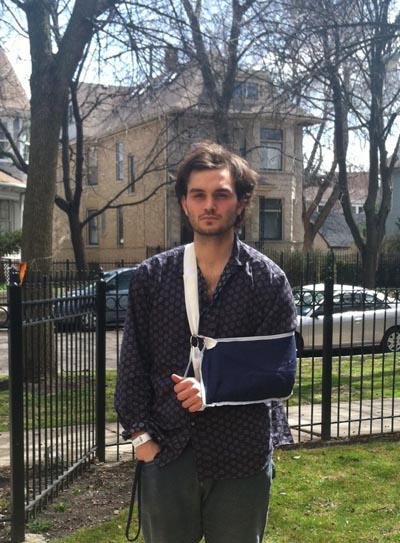
THE IDEA
The film came together around the drawings. Originally, it had a more ambitious storyline that was part sci-fi part HGTV, something about a man who ate furniture and reassembled it inside himself. But as I started figuring out the drawings, what really worked well was the almost plotless stuff of simple domestic routines, drawn into a fury. That opened it up for me, but I think the feeling of the original story is still there.
TOOLBOX
Mostly BIC #2 mechanical pencils. It’s all hand-drawn, pencil on paper, scanned, and edited & composited in After Effects.
LESSONS LEARNED
Get the drawings in the computer sooner and into a rough timeline. I think I underestimated how much of any movie comes together in the process of editing. I didn’t use storyboards in any strict sense and instead let the details dictate the pacing—half straight-ahead, half pose-to-pose—which is kind of like building a house from the top down. Some my favorite images came up that way, unexpectedly, but it isn’t until you put these pieces together that you see the larger shape of the film emerge, as well as connections and ideas that you may have missed initially.
INSPIRATIONS
Some favorites are James Duesing, Jim Trainor, Atsushi Wada, Suzan Pitt and Sally Cruikshank. When I was first starting on the project, I had just bought a book of Pascal Doury’s comics that I was carrying around everywhere. Along the way, I listened to a couple Raymond Chandler audiobooks and a bunch of Joe Frank radio shows.
WHERE YOU SEE YOURSELF IN FIVE YEARS
Hopefully hunched over a lightbox somewhere, smoking a cigar. Tough to say, but I’d like to find a way to keep making short animations, preferably in collaboration with some likeminded ne’er-do-wells.
FILMMAKER WEBSITES
Add a CommentBlog: Cartoon Brew (Login to Add to MyJacketFlap)
JacketFlap tags: Student, BrewTV, Sheridan College, Natan Moura, Shorts, Add a tag
 The Cartoon Brew Student Animation Festival is made possible by JibJab and their strong support for emerging filmmakers.
The Cartoon Brew Student Animation Festival is made possible by JibJab and their strong support for emerging filmmakers.
Clocking in at a brisk eighty seconds, Sun of a Beach by Natan Moura is the shortest film debut in Cartoon Brew’s 2013 Student Animation Festival. Moura made the film as a graduation project at Sheridan College in Oakville, Canada.
Every year, we receive numerous student film entries that are under two minutes long, but few of these micro-shorts exhibit the storytelling and filmmaking discipline that accompanies Moura’s film. Moura understands the value of not just every second, but every frame in his film, and uses it to his advantage. He uses his precious amount of screentime to put together a complete film with a character who has an arc and a story that has a beginning, middle and end. Moura communicates his ideas with a fun, bold visual style that seamlessly combines computer animation and hand drawn techniques.
Continue reading for comments from the filmmaker:
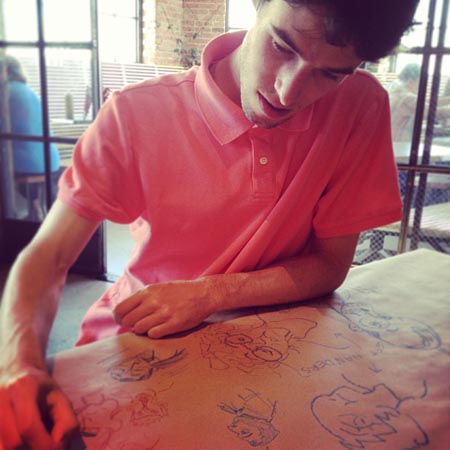
THE IDEA
During the making of my film I came to think of it as a kind of tribute to my childhood. I moved from Brazil to Canada at a young age and being on a beach has always been a magical place for me. Over the years, playing with my two very young brothers has brought me back to my own childhood and shifted my focus to more playful and whimsical stories. Like most of my ideas, it came to me at three in the morning while doodling. The the final story eventually came together when I was able to spend time observing people on the beach while living in Los Angeles the following summer.
TOOLBOX
My film was a 2D and 3D hybrid done in Flash and Maya and composited in After Effects. I was interested in experimenting with a more graphic 3D aesthetic. I felt like a flatter environment made the story more playful by bringing the sun closer to the people on the beach. This was mostly achieved by using an almost orthographic perspective in Maya and eliminating 3D lighting all together. The lighting effects were done in After Effects where they wouldn’t ruin the flatness I was going for. I also animated the smaller characters in Flash to more easily control their design. The entire film came together as a single After Effects file with over 300 layers! How the program didn’t crash is beyond me.
LESSONS LEARNED
The most important thing I learned is how to edit a story into only the essentials. It’s not something I believe needs to be done for every story but it’s a worthy exercise. Some of the best structured stories I’ve seen are commercials, simply because they have to hold your attention and have no time for anything but the basics. When I completed my first animatic at three minutes it was clear that my idea only needed a minute and that every second had to be justified. I think it’s important to not only ask yourself how long a story needs to work effectively, but also how much of someone’s time your idea is really worth.
INSPIRATIONS
In the earlier stages of story development I rewatched the film Before Sunrise and was reminded how effective a sustained shot can be in bringing the viewer into a story. Many people I talked to discouraged me from this limitation but I thought it would add a sense of realism to my film and also help maintain a flat aesthetic. I really believe that picking limitations is the most liberating thing you can do creatively and it couldn’t have helped me more in this case. I later decided to add a single cut to emphasize the tipping point of the story.
WHERE YOU SEE YOURSELF IN FIVE YEARS
I enjoy animating first and foremost but this early in my career I still feel there is much exploring to be done. While filmmaking was originally what attracted me to animation I see a lot of potential in new alternate forms of storytelling. I’ve recently become interested in the interactive possibilities of stories primarily in games and apps. Working at JibJab over the past couple of months brought me closer to programmers for the first time which has inspired me to think of stories from a different perspective. Being able to experiment and problem solve is what keeps things exciting for me and I hope to always have that kind of flexibility. [EDITOR'S NOTE: When Moura's film was selected for inclusion in the festival, we were not aware that he had recently been hired by the festival's sponsor JibJab.]
FILMMAKER WEBSITES
Add a CommentBlog: Cartoon Brew (Login to Add to MyJacketFlap)
JacketFlap tags: Barbara Bakos, Moholy-Nagy University of Art and Design, MOME, Shorts, Student, BrewTV, Add a tag
Lady with Long Hair by Barbara Bakos is our third debut in Cartoon Brew’s 2013 Student Animation Festival. The graduation film was produced at the Moholy-Nagy University of Art and Design in Budapest, Hungary.
The film tells the story of an old woman who relives memories of her life contained within her hair. Bakos tackles the challenging concept using hand-drawn animation to create a sweet, memorable personality for her protagonist. The character is depicted as both frail with age and full of life and strength, which comes through especially when she bakes.
The film moves into expressionist territory with a visual analogy that ties together the flow of water with the woman’s long wavy hair. It builds to a particularly poignant ending that uses the hair to merge the character’s current reality with her memories.
Technically, the film is impeccable, with an eye for detail in every aspect of the art direction. Bakos applies color elegantly to distinguish between her characters’ present and past. She also unveils the story with cinematic language and uses the hair as a striking compositional element in numerous scenes.
Continue reading for comments from the filmmaker:

THE IDEA
The idea of the film came from my family and from my own grandma. When I was a child, I spent most of the time with my grandparents because I never wanted to go to the kindergarten. So I had a lot of lovely memories and adventures with them. We would sit in the backyard playing with little fingerpuppets, painting, and baking cherry pies together, and I was always amazed at how much my grandparents loved each other. Since my grandpa passed away, my grandma lives alone. Her personality, her feelings, memories and her point of view inspired me to make this short film about her lifelong love, and about that state of mind where you just can’t let go of the most important person in your life.
I have also a strange obsession with the hair. A few years ago it became my obsession to draw skyhigh hair and create little worlds in them depending on the characters it belonged to. I always think that hair is one of the most characteristic things about a person. How she/he styles it, or what colour it is. So when I started to develop this short film, I felt that I had to connect these two things.
TOOLBOX
It’s a traditionally hand-drawn animated film. I chose this technique because of the tactile nature of the medium, and I thought this was the best way to create a connection with the audience. During the whole film we are focusing on one granny. She has to tell us her past and her memories through her facial expressions rather than dialogue. Also I was using traditionally painted backgrounds and props. I then put together the final picture in After Effects.
CHALLENGES
It was the first time that I had to inspire and lead a lot of people at the same time—animators, editor, music composer, actress, 3D artist. It was also very useful to learn how to convince them that your idea is good, unique and worth the hard work! But the biggest challenge was to present the idea to my family and my grandma. It was an amazing moment when I saw my grandma’s face while she was watching the film.
INSPIRATIONS
Storywise and also visually, I was inspired by a lot of short films. I was most impressed by The Man with Beautiful Eyes from Jonathan Hodgson and Charles Bukowski, Father and Daughter from Michael Dudok de Wit, Sunday from Patrick Doyon and La Maison en Petits Cubes from Kunio Katō. I love stories that are based on childhood, and not just childhood, but how we remember those times—how memories are working if for instance, you go back to the same place where you grew up or spent summers. What kind of thoughts appear in your mind when you sense a familiar smell or the light is exactly the same as on an autumn afternoon decades ago.
WHERE YOU SEE YOURSELF IN FIVE YEARS
Right now, I am a freelancer art director and illustrator, which I really love. At the same time I would love to work in a big team where people can inspire each other. Also I am developing a new short at the moment so I really hope that five years from now it will be finished ☺
FILMMAKER WEBSITES
Personal website: BarbaraBakos.com

The Cartoon Brew Student Animation Festival is made possible by the generosity of our presenting sponsor JibJab. Add a Comment
Blog: Cartoon Brew (Login to Add to MyJacketFlap)
JacketFlap tags: Shorts, Student, BrewTV, *Promote Video, Eric Ko, RISD, Rhode Island School of Design, Add a tag
This morning we continue Cartoon Brew’s Student Animation Festival with the online debut of Eric Ko’s Our Son (우리 아들) which is a graduation short produced at the Rhode Island School of Design.
Notably, Eric’s short marks the second time he’s been selected for our festival; his junior year film Troubleshooting was featured in last year’s festival. Our Son is an evolution of his distinctively spare geometric language while reaching new heights of filmmaking ambition and confidence.
Ko is fascinated with the idea of speed in this film, and he skillfully manipulates the cinematic space to create a fast-paced and exciting animation thrill ride. The driving percussion-oriented soundtrack lends to the sense of urgency. The film flirts with abstraction, but remains grounded in a narrative universe that is both resistant to (and demanding of) interpretation by the viewer.
Continue reading for comments from the filmmaker:
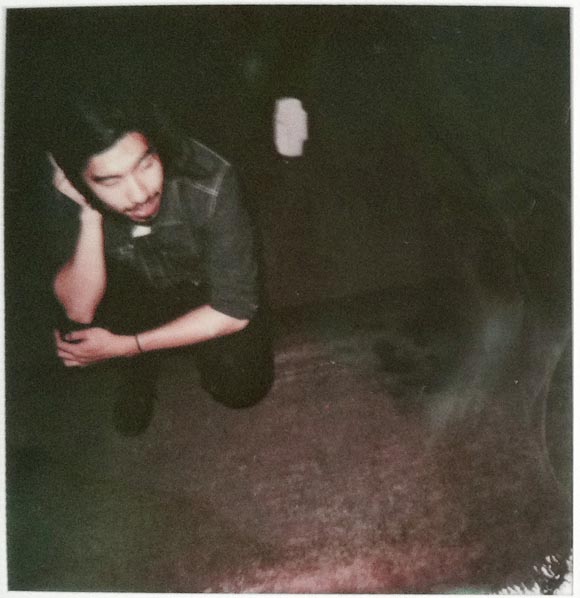
THE IDEA
The transition from carefree irresponsibility to reality is often instantaneous. Based off of a few precious memories of growing up with a best friend in a place that offered very little and the relationship I have with my heritage, I wanted to work on a film that took me on an adventure during its creation, with hopes that it would take the viewer on one as well.
TOOLBOX
I used Flash and a tablet to animate. For the music and sound design I worked in Ableton Live.
CHALLENGES & LESSONS LEARNED
I wanted to make a film that embodied impulsive, frantic adventures; with that said, having a storyboard seemed to be an ill limitation. At first I had plenty of boards drawn up and ideas down on paper, but after the first few seconds of animating I threw it all out. All I had left were the bigger ideas that I kept in the back of my head as I worked. At a certain point I was simply putting one image in front of the other without knowing what came next, which was fun for me. Once something stopped being fun, I stopped and changed it. I think realizing to make sure I had fun was the most important thing.
INSPIRATIONS
I looked up to independent animators such as Lei Lei and Misaki Uwabo. I did some really basic research on Korean culture; I think my vague understanding of my own heritage and the disjointed humor I get from it particularly inspired me. Also, retro side-scrolling spaceship games such as Gradius interests me a lot, where a lot of strange visual motifs went unquestioned because it’s an arcade game. While animating I listened to a lot of Louis CK interviews for laughs and really loved his attitude about creative freedom. Echo Park by Willamette was my favorite album to listen to.
WHERE YOU SEE YOURSELF IN FIVE YEARS
Making more short films!
FILMMAKER WEBSITES
Personal website: Crybird.net
Vimeo page: Vimeo.com/EricKo

The Cartoon Brew Student Animation Festival is made possible by the generosity of our presenting sponsor JibJab. Add a Comment
Blog: Cartoon Brew (Login to Add to MyJacketFlap)
JacketFlap tags: Shorts, Student, BrewTV, Ringling College of Art and Design, Joon Shik Song, Joon Soo Song, Josiah Haworth, Add a tag
Welcome to the fourth annual Cartoon Brew Student Animation Festival. Every Monday morning for the next eight weeks we’ll be debuting one of these remarkable student animated shorts selected from among hundreds of submissions.
We begin the festival today with our Grand Prize winner, Brain Divided, a film directed by Josiah Haworth, Joon Shik Song and Joon Soo Song at Ringling College of Art and Design. The film, which will receive a cash prize of $1,000(US), was selected for the top award by this year’s guest judge Evan Spiridellis of JibJab. Cartoon Brew would also like to thank JibJab for their sponsorship of this festival. Their strong support for student filmmakers makes this event possible.
Brain Divided succeeds on every level as an animated short. The filmmmakers’ command of both animation and technology is flawless. But the value of their film lies in how they apply their technical skills toward making an entertaining and funny film. They take advantage of every opportunity for visual humor and delight us with sharply timed gags. The personalities in the film are especially well defined: the two human characters strike just the right balance of comedy and believability, while the two sides of the brain have a satisfying evolution as characters within the span of the film.
Continue reading for comments from the filmmakers:

THE IDEA
The dating game is one of the most nerve wracking experiences that anyone can go through. So we thought that this would be a great story to pursue. The original concept started off as two guys attempting to impress a beautiful Disney Princess-esque girl, but it lacked character, fun, and a more dynamic relationship between the two main characters. One day while surfing the web and brainstorming we were inspired after seeing an animation clip of the classic angel vs. devil on the shoulder complex. we instantly thought of Kronk in The Emperor’s New Groove. Watching the interactions of his shoulder angel and devil was always hilarious and we wanted to try and recreate that comedy in our own film. However, we knew that the this concept has been done a lot in the past so we wanted to put our own spin on it. This led us to come up with the idea that the “Angel” and “Demon” were actually the “Left” and “Right” side of the brain fighting for control. We thought it would be great to literally go inside the head and see the physical battle that ensues within the mind and its effect on our main character. This gave us everything we wanted, a fun and simple story, with a broad range of character animation that we could play with.
TOOLBOX
All animation and lighting was done in Autodesk Maya 2013 using the Renderman plugin using linear workflow. All four of our characters were rigged using The Setup Machine (TSM) with some modifications, thanks to Jeremy Cantor, that allowed us to get a bit more versatility. Post processing, compositing, and effects were done in NukeX and edited together using Adobe Premiere. Adobe Photoshop allowed us to tweak individual frames as well as test lighting ideas. All of the software and powerful HP workstations that we used were provided by Ringling, as was use of the school’s powerful render farm.
CHALLENGES
One of the biggest challenges was writing and creating good comedy while making the story flow and work seamlessly. Because our piece was strongly dialogue driven, we needed to write a script that was witty, charming and real. It was very difficult because we had no prior experience in screenplay at all. It was a lot of trial and error while simultaneously coming up with fun slapstick comedy, and juggling the variety of characters that we had. It really pushed our storytelling abilities and writing capabilities to another level. Also, our film was one of the longest to come out of Ringling and keeping it all organized and on time was a huge undertaking. We had approximately 90+ shots to animate and light, split up between the three of us. But to make the films visuals work better we had to learn how to use Nuke, and before the final semester of school we had never used it. Juggling thirty shots each while learning new software gave us our fair share of sleepless nights.
LESSONS LEARNED
The most important things we learned from our film was how to streamline story and to trust in your team. Often times shots ran too long or were too complicated and we found that they read much better when they were simplified. This may mean taking out an unnecessary pose or changing the acting entirely. But making these changes helped create a well paced film that had all the entertainment and character we wanted. Even though we had never worked on a team at Ringling before, we entered this film with the confidence we could get it done and hopefully make it funny. Although creating the film was extremely difficult and stressful, through trust, constant communication, and with the help of a 24 hour Denny’s we learned how vital teamwork is to completing a film.
INSPIRATIONS
We drew a huge inspiration from actors such as Jim Carrey from The Mask and Eddie Murphy from Doctor Dolittle as well as animated characters like Pepe Le Pew and Kronk from The Emperor’s New Groove. All of them had elements that we loved to watch and wished to emulate in our film. A lot of inspiration also came from the students around us and the incredible work they were doing on their films. It was a real driving force that motivated us to make our film the best it could be. Our faculty was equally inspiring and provided us with an enormous amount of feedback and great advice.
WHERE YOU SEE YOURSELF IN FIVE YEARS
Josiah Haworth: My goal is to be doing character animation for a major studio or an up and coming studio. Of course Disney, ReelFX, and Bluesky are high on that list! Just give me a mouse, Maya, and a project and I’m good to go!
Joon Soo Song: I want to be animating. I’d love to work at Disney, Dreamworks, Pixar, Blue Sky, Blizzard, Blur, Laika, ReelFX, Insomniac, and the list goes on. As long as I’m animating I’ll be happy.
Joon Shik Song: I want to be at Disney working my way towards directing or animation supervisor. If I’m lucky I’ll be hanging out with Mickey Mouse talking about our next feature film. It’ll be just like the good old days at Ringling, late nights and coffee breaks :)
FILMMAKER WEBSITES
Josiah Haworth: Personal website and Animation Reel
Joon Soo Song: Animation Reel
Joon Shik Song: Animation Reel
Brain Divided Facebook Page

The Cartoon Brew Student Animation Festival is made possible by the generosity of our presenting sponsor JibJab. Add a Comment
Blog: Cartoon Brew (Login to Add to MyJacketFlap)
JacketFlap tags: Shorts, Student, Bezalel Academy of Arts and Design, Sariel Keslasi, Add a tag

Altneuland (Old New Land) is a 2012 graduation film directed by Sariel Keslasi at Bezalel Academy of Arts and Design in Jerusalem. In the film, Keslasi re-interprets Theodor Herzl’s 110-year-old utopian novel Altneuland through contemporary eyes. He writes:
By using a surrealist allegory, the film tries to deal with the collapse of Herzl’s dream and seeks to emphasize the sense of absurdity and instability of my personal experience as an individual in the Israeli society.
I met the thoughtful Keslasi a few months ago at the Anifilm festival in the Czech Republic, where his film was in competition. Altneuland also was in competition at Annecy last month. Keslasi’s strong art direction and his cinematic eye for staging and cutting has already landed him work in the Israeli animation scene, where he recently worked on Ari Folman’s feature The Congress.
Add a CommentBlog: Cartoon Brew (Login to Add to MyJacketFlap)
JacketFlap tags: Shorts, Student, Anna Pearson, Edinburgh College of Art, Add a tag
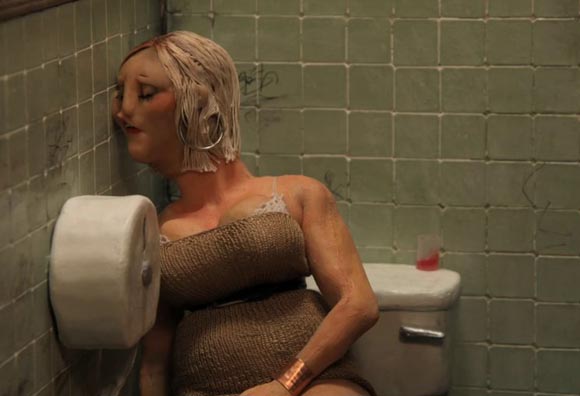
Anna Pearson directed Out on the Tiles as a graduation film in 2010 at Edinburgh College of Art. The film evokes a surprising amount of pathos for its small-scale drama. Credit that to the finely observed personality animation. I could feel the character’s blurry and impaired thought process behind every action on screen.
(via Stop Motion Portugal)
Add a CommentBlog: Cartoon Brew (Login to Add to MyJacketFlap)
JacketFlap tags: Shorts, Student, CalArts, Artist of the Day, Omelette, Madeline Sharafian, Add a tag
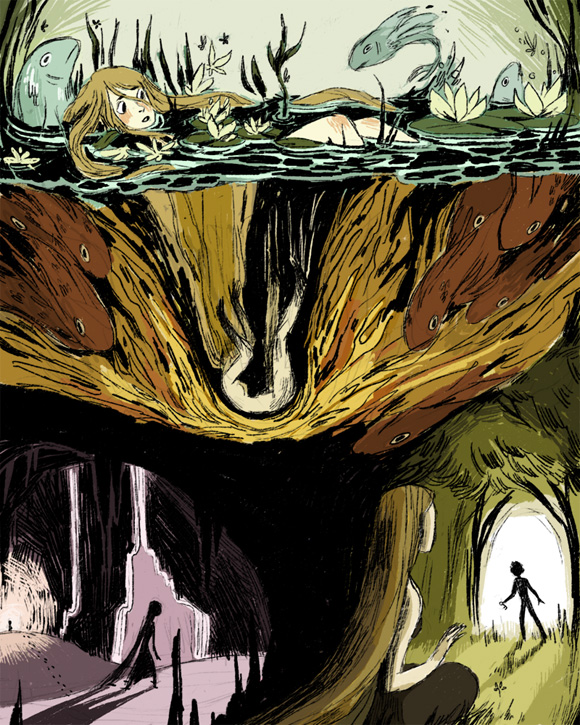
Madeline Sharafian recently completed her second year studying animation at CalArts where she made the film Omelette:
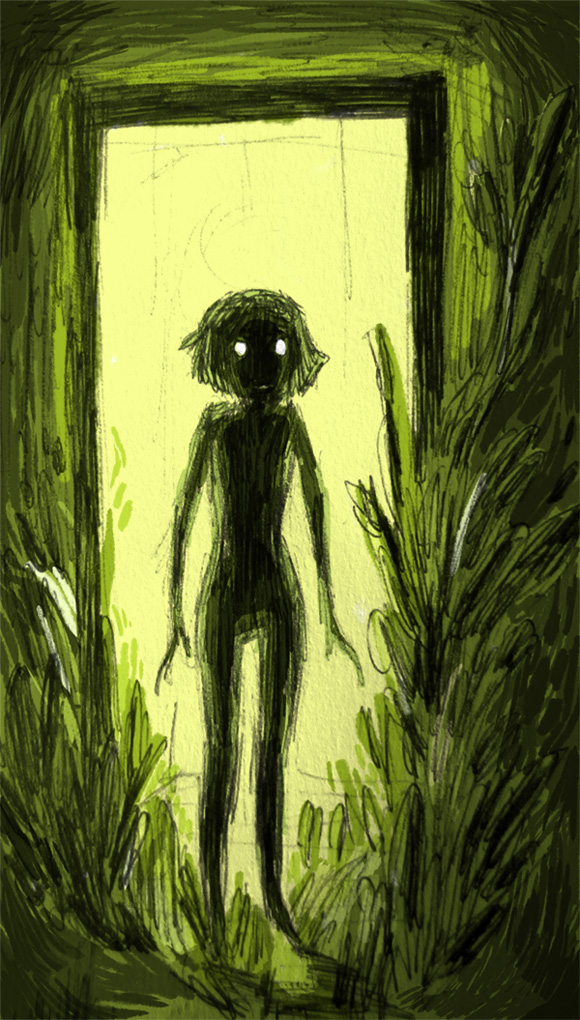
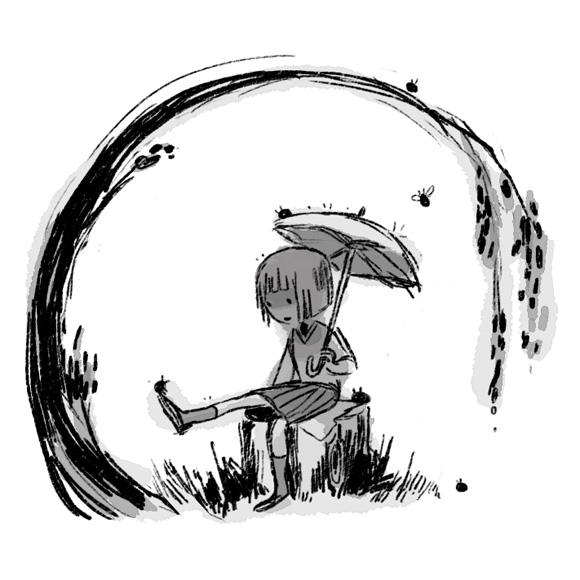
In these drawings, Madeline sketches out simple, rough lines and varying values to frame her characters in an accomplished way.
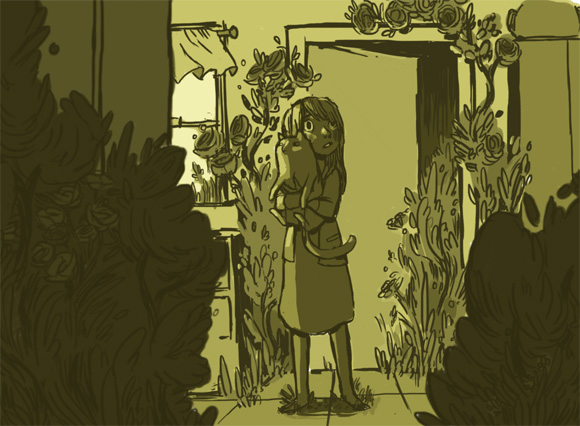
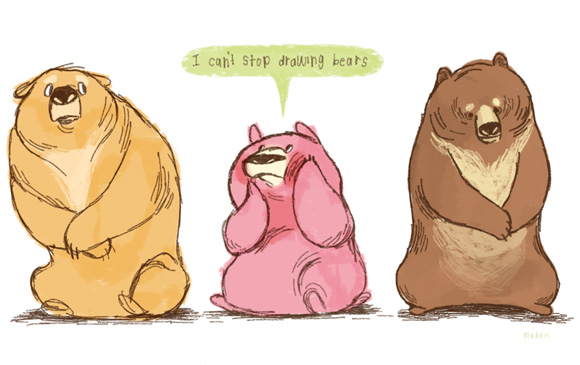
See more of Madeline’s work on her blog and Tumblr.
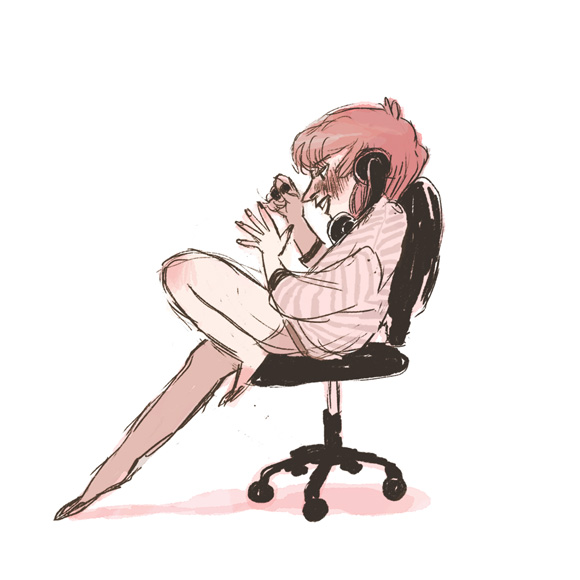
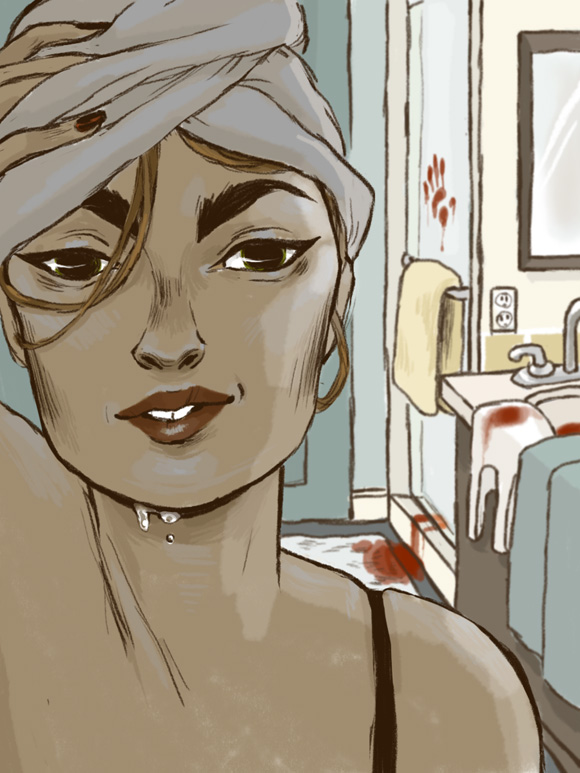
Blog: Cartoon Brew (Login to Add to MyJacketFlap)
JacketFlap tags: Shorts, Student, RISD, University of Southern California, MassArt, Rhode Island School of Design, CalArts, USC, DePaul University, Sheridan College, Ringling College of Art and Design, Cartoon Brew Student Animation Festival, Eric Ko, Alex Horan, Barbara Bakos, Brain Divided, California Institute of the Arts, Dumb Day, Isabela Dos Santos, Joon Shik Song, Joon Soo Song, Josiah Haworth, Kevin Eskew, Lady with Long Hair, Louis Morton, Massachusetts College of Art and Design, Moholy-Nagy University of Art and Design, Natan Moura, Our Son, Passer Passer, Sun of a Beach, Wolf Within, Add a tag
For the fourth year in a row, we are delighted to present the Cartoon Brew Student Animation Festival, the premier online showcase for animated short premieres by student filmmakers.
Our 2013 festival offers one of the strongest and most dynamic slates of short films since we launched the festival. Chosen from a record-breaking 266 film submissions, the eight films in this year’s festival represent a remarkably high level of creative vision and filmmaking skill. The films selected were made by adventurous filmmakers who show a commitment to exploring the narrative and visual possibilities of the animation art form, and whose ideas and concepts are fully realized.
More quality student work was submitted than ever before. In fact, half of the films in this year’s festival are from schools that haven’t been in the festival during its first three years—Moholy-Nagy University of Art and Design, DePaul University, University of Southern California and Massachusetts College of Art and Design. On the other hand, Eric Ko is the first filmmaker who has been selected twice for the festival; his junior film Troubleshooting was a part of our festival last year.
 Each of the eight filmmakers whose work is featured in this year’s festival will receive a cash award of $500 (US), thanks to the generosity of our festival sponsor JibJab. Further, Evan Spiridellis, the co-founder of JibJab, will select one additional film to receive the Grand Prize and an extra $500, for a cash prize totalling $1,000 US.
Each of the eight filmmakers whose work is featured in this year’s festival will receive a cash award of $500 (US), thanks to the generosity of our festival sponsor JibJab. Further, Evan Spiridellis, the co-founder of JibJab, will select one additional film to receive the Grand Prize and an extra $500, for a cash prize totalling $1,000 US.
The festival will debut on Monday, July 8th, and a new film will be presented every week throughout July and August. And now, we proudly present the 2013 class of Cartoon Brew’s Student Animation Festival:
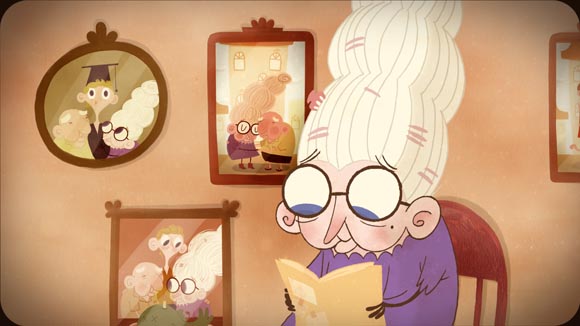
Lady with Long Hair
Directed by Barbara Bakos
School: Moholy-Nagy University of Art and Design (Hungary)
Synopsis: An old lady relives memories of her life contained within her hair.
Running time: 8 min 45 s
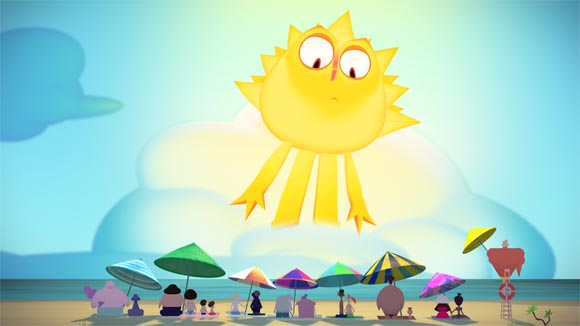
Sun of a Beach
Directed by Natan Moura
School: Sheridan College (Canada)
Synopsis: Shunned for shining a little too brightly, the poor sun feels alone in its search to connect and be wanted.
Running time: 1 min 20 s
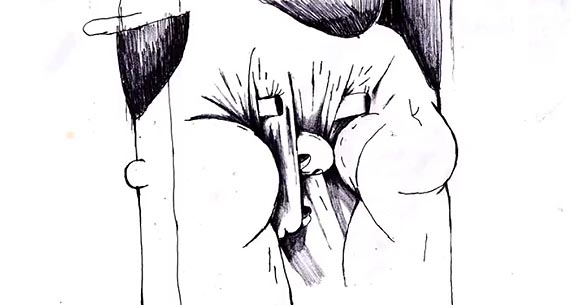
Dumb Day
Directed by Kevin Eskew
School: DePaul University (USA)
Synopsis: Flower sniffing, carpet calisthenics, and other restless leisure-time activities. Domestic life can be tough. Finally, the day breaks.
Running time: 9 min 30 s
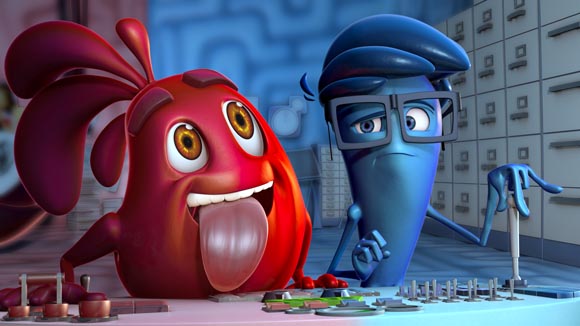
Brain Divided
Directed by Josiah Haworth, Joon Shik Song and Joon Soo Song
School: Ringling College of Art and Design (USA)
Synopsis: The story about an ordinary guy who meets a not so ordinary girl, but his brain cells can’t agree on how to go about winning her over, which leads to Conflict!
Running time: 5 min

Our Son (우리 아들)
Directed by Eric Ko
School: Rhode Island School of Design (USA)
Synposis: Celestial bodies and the fragility of happiness.
Running time: 4 min 30 s
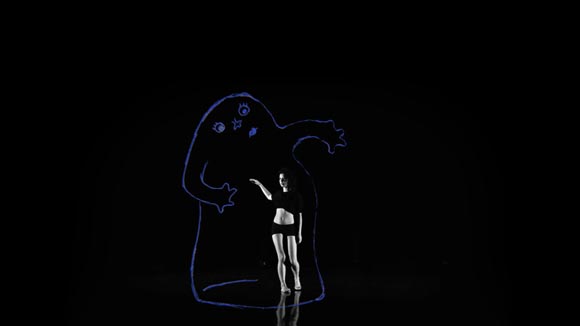
i
Directed by Isabela Dos Santos
School: California Institute of the Arts (USA)
Synopsis: Hand-drawn animation and dance performance intersect and interact in this short piece that deals with a well-known question: Who am I?
Running time: 3 min 35s
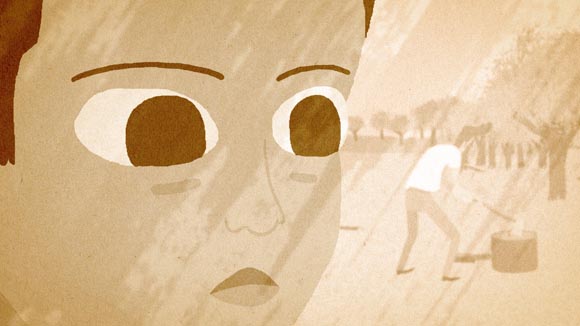
Wolf Within
Directed by Alex Horan
School: Massachusetts College of Art and Design (USA)
Synopsis: A father prepares his son for a world without him.
Running time: 9 min 35 s
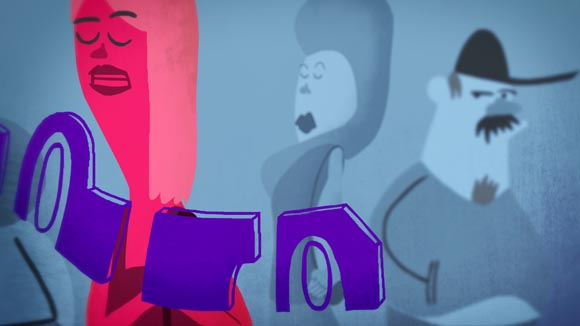
Passer Passer
Directed by Louis Morton
School: University of Southern California (USA)
Synopsis: An animated city symphony celebrates the hidden world of background noise. Field recordings from the streets of Los Angeles and Tokyo drive imagined characters and cycles that build to form a living musical creature.
Running time: 3 min 47 s
Blog: Cartoon Brew (Login to Add to MyJacketFlap)
JacketFlap tags: Shorts, Student, SVA, School of Visual Arts, Dana Terrace, *Promote Video, Iker Maidagan, Add a tag
Mirage was among the most outstanding thesis films from the 2013 class of the School of Visual Arts. It’s about a young Inuit boy and his dog who go out into the bleak Arctic wilderness to fish, only to discover strange happenings lurking beneath the frozen waters.
The film was a joint effort between Iker Maidagan, who came up with the story and did the layouts, and Dana Terrace, who designed and animated the characters. Working as a team, they were able to focus on their artistic strengths and apply them to a single project. Everything, from story concept to animation to final compositing, and all the steps in-between, are flawlessly executed.
Knowing both Iker and Dana personally from my time attending SVA, I can say that they both have a very strong understanding of the process, not just as animators, but as filmmakers and storytellers. I don’t think I have ever seen a student film that feels as complete and polished as a studio-produced short, but this one certainly comes close, if not surpassing it.
Add a CommentBlog: Cartoon Brew (Login to Add to MyJacketFlap)
JacketFlap tags: Christine Kim, Elaine Wu, Shorts, CGI, Student, Ringling College of Art and Design, Add a tag
It’s refreshing to see a student short where the filmmakers just get it. The Chicken or the Egg by Christine Kim and Elaine Wu is a solid piece of entertainment in every respect: storytelling, pacing, cutting, character animation, sound design, you name it. They produced the film at Ringling College of Art and Design.
(Thanks,Yoav Shtibelman, via Cartoon Brew’s Facebook page)
Add a CommentBlog: Cartoon Brew (Login to Add to MyJacketFlap)
JacketFlap tags: Shorts, Student, The Animation Workshop, *Promote Video, Giovanni Braggio, Add a tag
For his thesis film at the Animation Workshop in Denmark, Giovanni Braggio made a helpful tutorial to teach the masses how easy animation can be:
Add a CommentBlog: Cartoon Brew (Login to Add to MyJacketFlap)
JacketFlap tags: Site News, Student, Cartoon Brew Student Animation Festival, Add a tag

Due to popular demand, we’re extending the deadline to submit to Cartoon Brew’s 4th Student Animation Festival until this FRIDAY, JUNE 7. Every filmmaker whose work is selected to screen in the online festival will receive $500 US. This year, guest judge Evan Spiridellis, the co-founder of JibJab, will select one additional film to receive the Grand Prize and a $1,000 cash prize. Go HERE for details on how to submit.
The film selections will be announced next week on Cartoon Brew.
Add a CommentBlog: Cartoon Brew (Login to Add to MyJacketFlap)
JacketFlap tags: Cartoon Brew Student Animation Festival, Site News, Student, Add a tag

A reminder to student filmmakers that just SIX days remain to submit your film to Cartoon Brew’s 4th annual Student Animation Festival. We’ve already had a record number of submissions this year, but we’re still looking for great student films to share with the animation community.
Every filmmaker whose work is selected to screen in the online festival will receive $500 US. This year, guest judge Evan Spiridellis, the co-founder of JibJab, will select one additional film to receive the Grand Prize and a $1,000 cash prize. Go HERE for all the details.
Add a CommentBlog: Cartoon Brew (Login to Add to MyJacketFlap)
JacketFlap tags: CalArts, Tom Law, I Always Look Angry, Student, *Promote Video, Add a tag
CalArts student Tom Law has an idiosyncratic sense of design and movement, which comes through clearly in his graduation short This Actually Happens A Lot. The short attempts to find a visual solution for representing a character’s social anxiety and insecurity, which Law achieves by tweaking the rules of gravity. We featured Tom’s self-portrait timelapse piece I Always Look Angry in a 2011 installment of Animated Fragments.
Add a CommentBlog: Cartoon Brew (Login to Add to MyJacketFlap)
JacketFlap tags: Shorts, Photoshop, Student, USC, *Promote Video, Simón Wilches-Castro, Add a tag
USC student Simón Wilches-Castro sent a message to let us know about his new short, Semáforo (Stoplight), inspired by the street performers of Colombia:
Due to the ongoing war in the Colombian jungles, many people are forced to flee their rural territories and find refugee in capital cities. Their only mean of acquiring money is to put on shows under the city stoplights. Some dress like clowns or do acrobatics, others spit fire or juggle; and some show the only thing they have left: deformities and amputations in exchange for some sympathy and change. This is the life of the people who live under a stoplight and the people who watch them.
Castro’s animation (made in Photoshop) is fun and creative, and he takes full advantage of the cinematic possibilities of the medium. The film will screen in competition at the Annecy festival next month.
Add a CommentBlog: Cartoon Brew (Login to Add to MyJacketFlap)
JacketFlap tags: Artist of the Day, Debora Cruchon, Illustration, Student, Gobelins, Add a tag
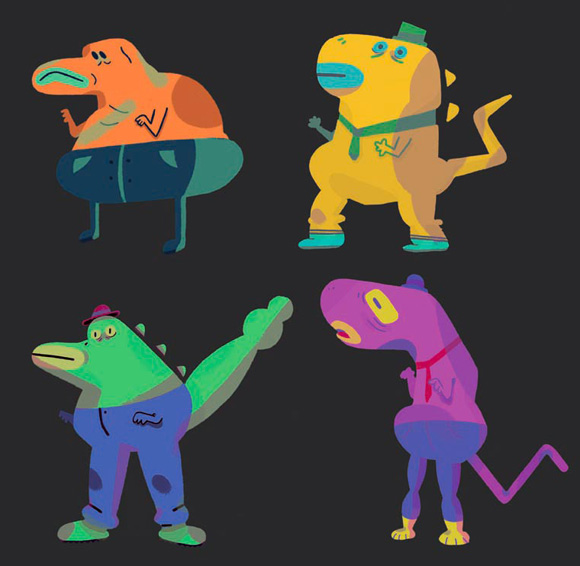
Debora Cruchon is studying animation at Gobelins, and keeps her portfolio work online here.

She also has a blog, supersalmon, where you can find animated loops, charcoal drawings, and paintings.

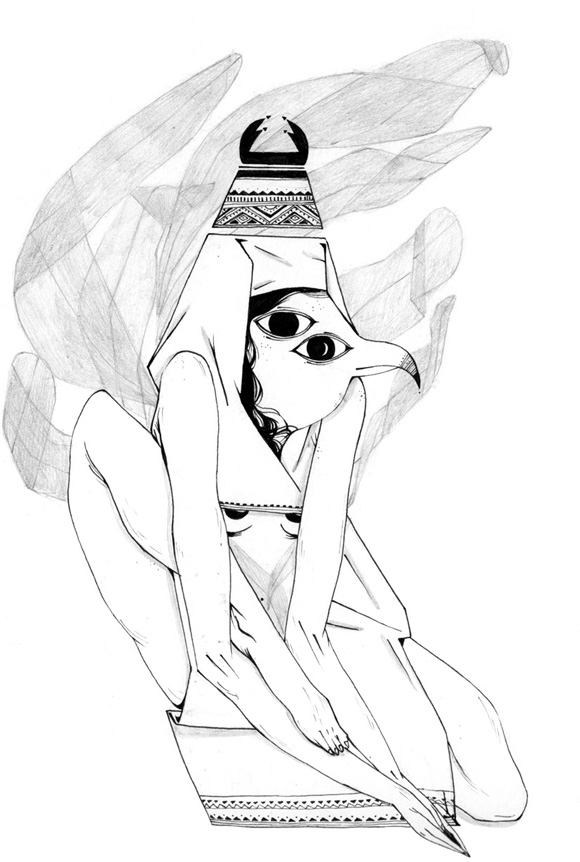
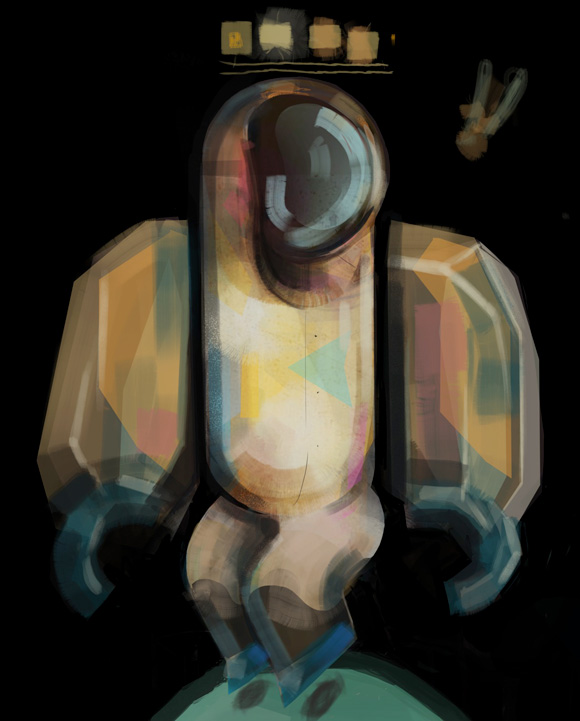
Her ink and watercolor sketchbook work have a playful experimentality, resulting in appealing and curious images.
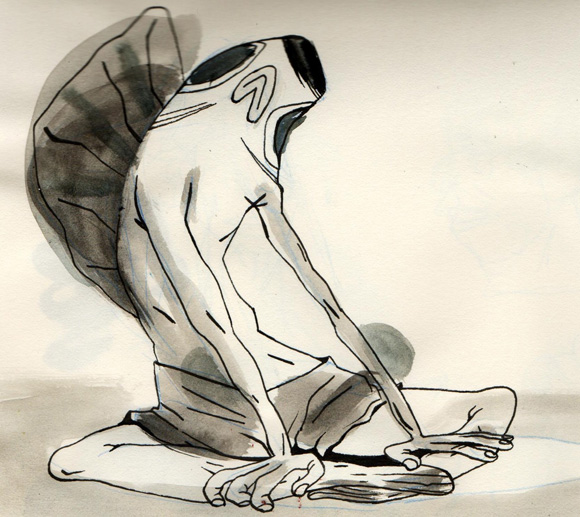
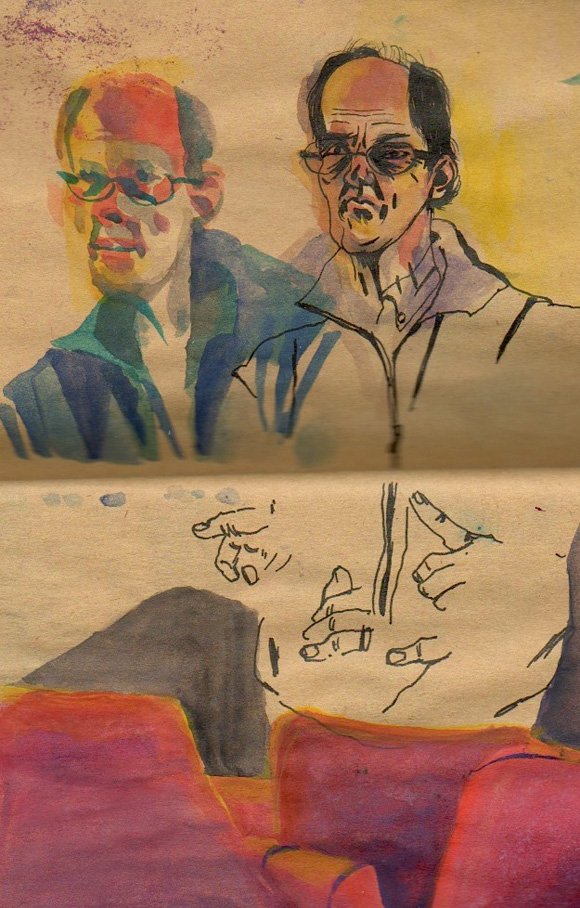
View Next 25 Posts


